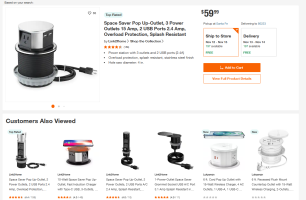Thank you guys, I concur.
We were having an in-house discussion about this, and getting an idea of what the mainstream view of this was very helpful.
One item my boss found that might be useful to future individuals searching for this answer, so I am copying part of his email. No offense to the Canadians, he's talking about a specific case:
The technical specifications indicate the product is listed to comply with two standards, UL 962A and CSA C22.2., and the latter is irrelevant because it is a Canadian standard.
It is evident from the scope UL 962A that this product is not listed to be installed in a kitchen countertop that is affixed in a building and subsequently regulated by the code. This product is listed to be installed on a non-fixed piece of furniture like a desk. We will not accept the installation being proposed by the contractor because it would violate the product listing, and it is potentially unsafe to do so. If we come across an installation like this during an inspection, it should be identified as a violation that requires corrective action (removal).
The scope of UL Standard 962A clearly indicates
1 Scope
1.1 These requirements cover indoor use cord and plug connected of permanently connected, furniture power distribution units (FPDU) rated 250 V AC or less and 20 Amperes or less. An FPDU may provide one or more receptacle outlets, inclusive of one current tap integral to the attachment plug, if provided, for connection of utilization equipment. An FPDU may include an integral Class 2 power supply employing integral output lead(s) and/or output connector(s) and may include receptacles with integral power supplies employing Class 2 output connector(s). FPDU’s are for fixed mounting to portable or stationary furnishings as a power supply connection for cord and plug connected electrical utilization equipment in accordance with the National Electrical Code, NFPA 70.
1.2 In accordance with the National Electrical Code, NFPA 70, furniture power distribution units (FPDUs) shall not serve as fixed wiring of a structure or of fixed furnishings, such as but not limited to applications in permanent countertops of kitchens and bathrooms.
1.3 A cord-and-plug-connected product as described in 1 with less than three receptacle outlets and provided with a Luminaire is covered under the Standard for Portable Electric Luminaires, UL 153.
1.4 A cord-and-plug-connected product as described in 1 with less than three receptacle outlets and that employs an electromagnetic interference filter is covered under the Standard for Electromagnetic Interference Filters, UL 1283.
1.5 A cord-and-plug-connected product as described in 1 with less than three receptacle outlets and that employs a surge protective device (SPD) is covered under the Standard for Surge Protective Devices, UL 1449, for SPD Type 3.
1.6 A cord-and-plug-connected product as described in 1 that employs ground-fault protection is covered under the requirements for portable GFCIs in the Standard for Ground-Fault Circuit Interrupters, UL 943.
1.7 This standard does not cover FPDUs intended for use with medical equipment.
1.8 These requirements cover FPDUs provided with isolated secondary circuits.
1.9 These requirements cover FPDUs provided with batteries located in isolated secondary circuits.
1.10 A product that has a battery backup feature or other uninterruptible power supply equipment located in the Primary Circuit shall comply with the applicable requirements in the Standard for Uninterruptible Power Supply Equipment, UL 1778.
 h9MnCGVNGxWmpWEO6KUPMLoaAtOfEALw_wcB&gclsrc=aw.ds
h9MnCGVNGxWmpWEO6KUPMLoaAtOfEALw_wcB&gclsrc=aw.ds h9MnCGVNGxWmpWEO6KUPMLoaAtOfEALw_wcB&gclsrc=aw.ds
h9MnCGVNGxWmpWEO6KUPMLoaAtOfEALw_wcB&gclsrc=aw.ds